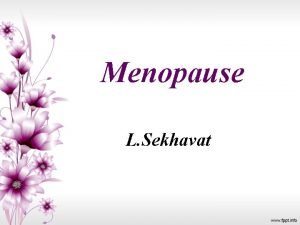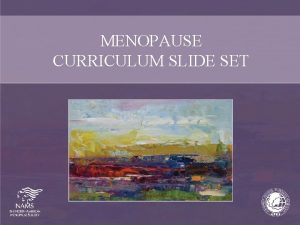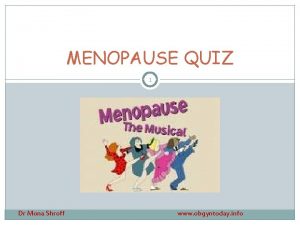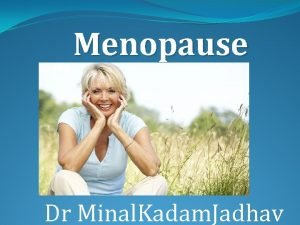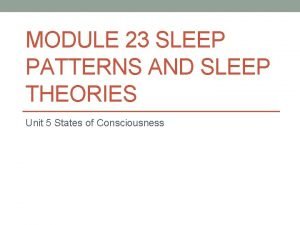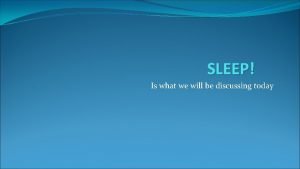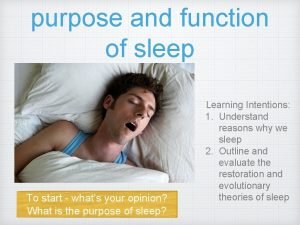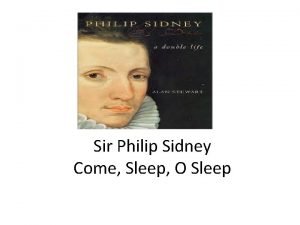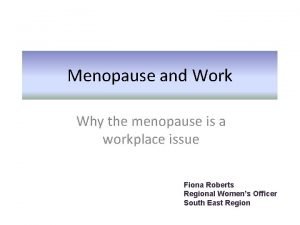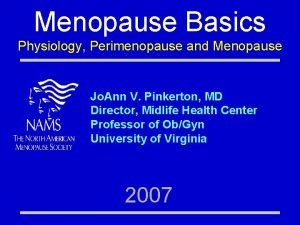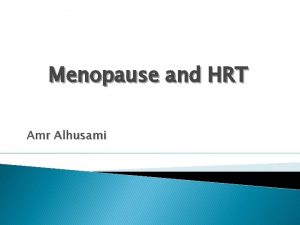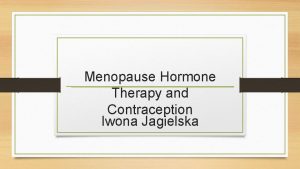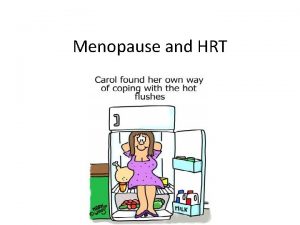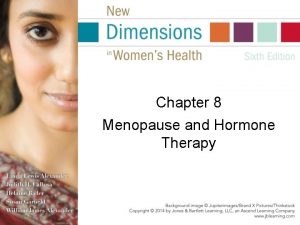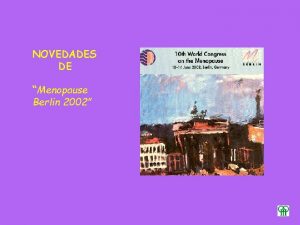Effects of menopause on sleep quality and sleep










- Slides: 10

Effects of menopause on sleep quality and sleep disorders: Canadian Longitudinal Study on Aging Sheida Zolfaghari 1, 2, Chun Yao 1, 2, Cynthia Thompson 3, Nadia Gosselin 3, 4, 8, Alex Desautels 3, 5, 8, Thien Thanh Dang-Vu 6, 7, 8, Ronald B. Postuma *2, 3, 8, Julie Carrier *3, 4, 7, 8 Integrated Program in Neuroscience, Mc. Gill University, Montréal, Québec, Canada Department of Neurology, Mc. Gill University, Montreal General Hospital, Montréal, Québec, Canada 3 Center for Advanced Research in Sleep Medicine, Hôpital du Sacré-Coeur de Montréal, Québec, Canada 4 Department of Psychology, Université de Montréal, Québec, Canada 5 Department of Neuroscience, Université de Montréal, Canada. 6 Center for Studies in Behavioral Neurobiology, PERFORM Center, Department of Health, Kinesiology and Applied Physiology, Concordia University, Montréal, Québec, Canada 7 Institut Universitaire de Gériatrie de Montréal and CRIUGM, CIUSSS du Centre-Sud-de-l’île-de-Montréal, Québec, Canada 8 Canadian Sleep and Circadian Network 1 2

Why it is important? • 40 -60% of middle age women! • Cause psychological and physical disorders: • • • Anxiety Depression Drug addiction Diabetes Hypertension Cardiac problems • Quality of life • Health costs y l n o t i Is ? e ag OR se? u a p no e M

Objectives • To compare 45 -60 -year-old post- and pre/perimenopausal women for: • Sleep quality • Sleep duration • Symptoms of sleep disorders • Adjusting for age and numerous potential confounding factors Menopause? ? ? Have you gone through menopause, meaning that your menstrual periods stopped for at least one year and did not restart?

Which sleep disorders? Sleep Onset Insomnia Disorder Defined based on DSM V criteria Sleep Maintenance Insomnia Disorder Defined based on DSM V criteria Daytime Somnolence Defined based on DSM V criteria Rapid Eye Movement Sleep Behavior Disorder (RBD) Defined based on RBD 1 Q screening tool Restless Legs Syndrome (RLS) Defined based on IRLSSG diagnostic criteria Obstructive Sleep Apnea Defined based on STOP questionnaire

Methods 30097 Participants (The whole cohort) 14777 men • CLSA Comprehensive Cohort 8353 women were not in 45 -60 age range • Baseline data 712 cases had hysterectomy 76 cases with missing data of menopausal status Post-Menopause (N=3713; 60%) Age: Mean (SD)=55. 72 (3. 3) Pre/Peri-Menopause (N=2466; 40%) Age: Mean (SD)=49. 80 (3. 1) N= 6179 Participants

Statistical Analysis • Regression Models: • Binary Logistic • Linear Regression • Adjusted for: • Age, Marital Status, Child Numbers, Education, Income, Satisfaction with Income, Use of Hormone Therapy, BMI, Physical Activity, Smoke, Alcohol, Diet, Anxiety, Depression, PTSD, Psychological Distress, Physician-diagnosed Thyroid Dysfunction, Cancer and Hypertension

Post-Menopause (N=3713) Pre/peri. Menopause (N=2466) 32. 4 (1203) 29. 0 (715) 1. 17 [1. 05 -1. 31] 1. 13 [0. 95 -1. 34] 6. 72 (1. 2) 6. 79 (1. 2) -0. 07 [(-0. 13)-(-0. 01)] -0. 08 [-0. 17 -0. 00] 20. 4 (758) 15. 5 (382) 1. 40 [1. 22 -1. 60] 1. 24 [1. 00 -1. 53] 10. 8 (292) 7. 3 (142) 1. 54 [1. 25 -1. 90] 1. 51 [1. 07 -2. 12] 28. 4 (1056) 27. 0 (666) 1. 07 [0. 96 -1. 20] 0. 99 [0. 83 -1. 18] 17. 0 (414) 14. 5 (230) 1. 21 [1. 01 -1. 44] 1. 07 [0. 81 -1. 42] Finding difficulty to stay awake during normal hours for at least 3/week – % (n) 7. 4 (274) 6. 7 (165) 1. 11 [0. 91 -1. 36] 1. 28 [0. 93 -1. 75] Possible daytime somnolence disorder – % (n) 1. 6 (50) 1. 3 (26) 1. 29 [0. 80 -2. 07] 1. 14 [0. 52 -2. 50] Snoring loudly – % (n) Stopped breathing in sleep – % (n) Possible obstructive sleep apnea – % (n) 23. 0 (751) 9. 6 (334) 14. 6 (504) 18. 7 (418) 7. 5 (174) 10. 4 (240) 1. 29 [1. 13 -1. 48] 1. 30 [1. 08 -1. 58] 1. 48 [1. 26 -1. 74] 1. 081 [0. 88 -1. 33] 1. 27 [0. 94 -1. 71] 1. 48 [1. 14 -1. 92] Acting out on dreams while asleep – % (n) 10. 1 (372) 11. 3 (278) 0. 88 [0. 75 -1. 04] 1. 02 [0. 80 -1. 31] Possible RBD (excluding confounds) – % (n) 3. 9 (102) 4. 0 (74) 0. 96 [0. 70 -1. 297] 1. 10 [0. 69 -1. 74] 35. 5 (1317) 31. 7 (782) 1. 18 [1. 06 -1. 32] 1. 17 [0. 90 -1. 38] 36. 7 (1360) 32. 6 (803) 1. 20 [1. 08 -1. 34] 1. 15 [0. 97 -1. 35] 24. 7 (694) 22. 0 (429) 1. 17 [1. 02 -1. 34] 1. 06 [0. 86 -1. 31] Sleep dissatisfaction, sleep hours, and sleep disorders in post-menopausal and pre/peri-menopausal groups Sleep Satisfaction Sleep Hours * Insomnia (Onset) Dissatisfaction with current sleep pattern – % (n) Number of sleep hours during past month – Mean (SD) Requiring more than 30 min to fall asleep for at least 3/week – % (n) Possible sleep-onset insomnia disorder – % (n) Waking up and having difficulty falling asleep Insomnia again for at least 3/week – % (n) (Maintenance) Possible sleep-maintenance insomnia disorder – % (n) Daytime Somnolence OSA RBD RLS Experiencing uncomfortable feeling in legs while sitting or lying down – % (n) Experiencing urge to move legs while sitting or lying down – % (n) Possible restless leg syndrome – % (n) Crude Odds Ratio Adjusted Odds Ratio [95% CI]

Post-Menopause (N=3713) Pre/peri. Menopause (N=2466) 32. 4 (1203) 29. 0 (715) 1. 17 [1. 05 -1. 31] 1. 13 [0. 95 -1. 34] 6. 72 (1. 2) 6. 79 (1. 2) -0. 07 [(-0. 13)-(-0. 01)] -0. 08 [-0. 17 -0. 00] 20. 4 (758) 15. 5 (382) 1. 40 [1. 22 -1. 60] 1. 24 [1. 00 -1. 53] 10. 8 (292) 7. 3 (142) 1. 54 [1. 25 -1. 90] 1. 51 [1. 07 -2. 12] 28. 4 (1056) 27. 0 (666) 1. 07 [0. 96 -1. 20] 0. 99 [0. 83 -1. 18] 17. 0 (414) 14. 5 (230) 1. 21 [1. 01 -1. 44] 1. 07 [0. 81 -1. 42] Finding difficulty to stay awake during normal hours for at least 3/week – % (n) 7. 4 (274) 6. 7 (165) 1. 11 [0. 91 -1. 36] 1. 28 [0. 93 -1. 75] Possible daytime somnolence disorder – % (n) 1. 6 (50) 1. 3 (26) 1. 29 [0. 80 -2. 07] 1. 14 [0. 52 -2. 50] Snoring loudly – % (n) Stopped breathing in sleep – % (n) Possible obstructive sleep apnea – % (n) 23. 0 (751) 9. 6 (334) 14. 6 (504) 18. 7 (418) 7. 5 (174) 10. 4 (240) 1. 29 [1. 13 -1. 48] 1. 30 [1. 08 -1. 58] 1. 48 [1. 26 -1. 74] 1. 081 [0. 88 -1. 33] 1. 27 [0. 94 -1. 71] 1. 48 [1. 14 -1. 92] Acting out on dreams while asleep – % (n) 10. 1 (372) 11. 3 (278) 0. 88 [0. 75 -1. 04] 1. 02 [0. 80 -1. 31] Possible RBD (excluding confounds) – % (n) 3. 9 (102) 4. 0 (74) 0. 96 [0. 70 -1. 297] 1. 10 [0. 69 -1. 74] 35. 5 (1317) 31. 7 (782) 1. 18 [1. 06 -1. 32] 1. 17 [0. 90 -1. 38] 36. 7 (1360) 32. 6 (803) 1. 20 [1. 08 -1. 34] 1. 15 [0. 97 -1. 35] 24. 7 (694) 22. 0 (429) 1. 17 [1. 02 -1. 34] 1. 06 [0. 86 -1. 31] Sleep dissatisfaction, sleep hours, and sleep disorders in post-menopausal and pre/peri-menopausal groups Sleep Satisfaction Sleep Hours * Insomnia (Onset) Dissatisfaction with current sleep pattern – % (n) Number of sleep hours during past month – Mean (SD) Requiring more than 30 min to fall asleep for at least 3/week – % (n) Possible sleep-onset insomnia disorder – % (n) Waking up and having difficulty falling asleep Insomnia again for at least 3/week – % (n) (Maintenance) Possible sleep-maintenance insomnia disorder – % (n) Daytime Somnolence OSA RBD RLS Experiencing uncomfortable feeling in legs while sitting or lying down – % (n) Experiencing urge to move legs while sitting or lying down – % (n) Possible restless leg syndrome – % (n) Crude Odds Ratio Adjusted Odds Ratio [95% CI]

Conclusion • Menopause is associated with: • Sleep onset insomnia • Obstructive sleep apnea • Menopause is not associated with: • • • Satisfaction with sleep Number of sleep hours Sleep maintenance insomnia Daytime somnolence RBD RLS

Thanks for your attention!


